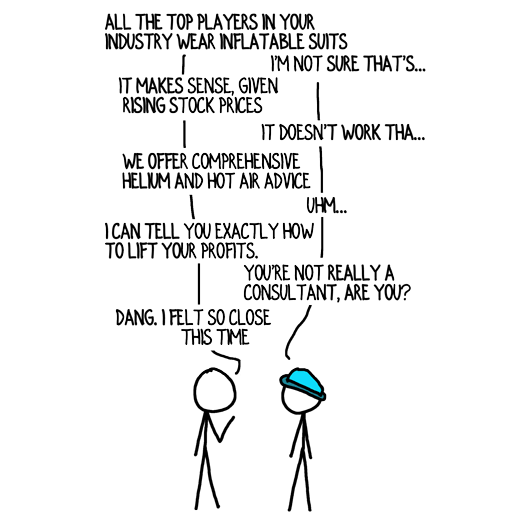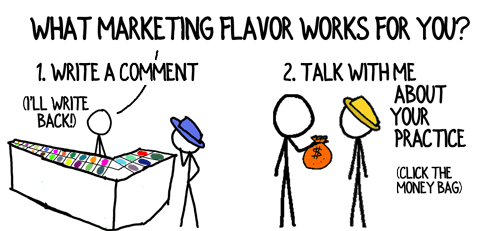Sit back and imagine your consulting firm as pure, rich, creamy scoops of ice cream. Prospects and consulting opportunities are the hot fudge that pours onto your icy practice in a steady, glossy stream of chocolatey richness.
When you put it that way, it’s hard not to like consulting, right?
Except, that you need to keep the fudge sauce hot—at least 165°F or the topping hits your firm in large, unpredictable lumps and clumps. If it cools down too much, the flow may stop entirely.
Lumps and clumps. That sums up most consulting firms’ revenue flow.
What’s the heat source that keeps your tasty pipeline of prospects hot? Marketing.
While marketing your consulting firm can seem daunting, it’s really quite simple.
5 Keys to Great, Consulting Firm Marketing
Have a Point of View
You should have a well-considered, Success Thesis: a rational explanation of why some of your clients’ competitors perform better than others.
Your point of view (i.e., your Success Thesis) doesn’t need to be unique, controversial or differentiated. However, you do need to be able to support your point of view with data, evidence, case studies and/or anecdotes.
Make Your Point of View Easy to Understand
Long, rambling explanations suck the energy and credibility from your Success Thesis.
Metaphors, models, and simple frameworks (like the classic 2×2 chart) are your friend. Test out your explanation on a slow-witted, adult relative. If he says, “Yeah, I get it,” while brushing the rainbow sprinkles from his chin, you’re good to go.
Make Your Point of View Actionable
Clients don’t hire consultants who are smart and have interesting ideas. Clients hire consulting firms that will tell them confidently and specifically what to do.
Whether your consulting firm offers advice, planning, implementation or some combination of those three, your marketing will only produce clients if you translate your Success Thesis into specific, granular action steps.
Shout Your Point of View Where Prospects Can Hear You
Prospects need to hear your point of view (obviously). That’s what the Five Marketing Musts are for.
Choose the marketing channels that fit your consulting firm’s strengths and your prospects’ likelihood to engage. If your best prospects read mangas, then illustrate your Success Thesis with Japanese-style drawings and post it on crunchyroll.com. (Let me know when you’re back from Googling all that.)
Market Now, and Later
Don’t wait until your Success Thesis is fully formed to start broadcasting. Announce your consulting firm’s thinking now.
Don’t wait until every one of your relatives understands your consulting firm’s concise message. Publish it now.
Don’t wait until your action steps are fully formed. Broadcast your Success Thesis now.
Don’t wait until the perfect, high-ROI marketing plan has been assembled. Jump into action now.
Don’t wait until all (or most) words, colors, images, or graphics are “right.” Market now.
That seems pretty clear.
Then repeat your consulting message. Over, and over.
Along the way, you can fine tune, adjust, shift, modify and even completely reverse your opinion. You can develop entirely new Success Theses, and try new channels.
As long as you consistently keep the heat up, attracting a steady flow of consulting clients is as easy as… well… eating ice cream.
In the comments, share your favorite marketing tip (or your favorite marketing metaphor).
Text and images are © 2024 David A. Fields, all rights reserved.

 David A. Fields Consulting Group
David A. Fields Consulting Group 

I opt for #2 “Easy to Understand”. Once I went to an elevator pitch class to learn how to explain “my thing” in 11 seconds. Even that seems too lengthy now, as the avg. attention span is down to 8 seconds. Thanks for your insightful and very clear post, David!
Eleven seconds turns out to be a long time. (Have someone speak to you non-stop for 11 seconds, then see how much of what they said you can repeat verbatim.) That’s why your Fishing Line is meant to be 15 words or less.
Most consultants can deliver their Fishing Line in 1-2 seconds. Of course, it takes 1-2 years to perfect, but that’s another matter!
Your experience with the elevator pitch class was very helpful to hear, Raymond. Thanks for adding it!
Thanks as always for your inspiration and enthusiasm, David! Love the lumpy clumpy hot fudge analogy – good point!
The perfect combination: useful content and chocolate. (That’s pretty much how I view consulting, overall.) I appreciate you chiming in, Mary Ann.
Could you elaborate on what exactly is “Success Thesis”? How does it relate to the Fishing Line?
Interesting question, Anatoli. Your Fishing Line concisely expresses who you work with and what problem you solve for them. It’s your one-line response to, “What do you do?”
Your Success Thesis, on the other hand, is your point of view on how to make your clients successful. You can have more than one of these, of course, as long as each one is well thought-out and expressed.
For instance, here’s a Success Thesis: “Step 0” of improving a consulting firm’s business development capability has nothing to do with business development. Rather, the rainmakers have to be confident that the firm can deliver new projects with quality. Therefore, before you invest in upgrading your business development skills, create flexible capacity.
Does that help? I’m glad you asked the question!
Thank you, David. I now understand it better.
What is then the role of Success Thesis in the sales process? How do I move from “Shout Your Point of View Where Prospects Can Hear You”, aka sharing IP, to selling more projects? I have created visibility at LinkedIn – at every professional event unfamiliar people recognize me as author of smart posts and comments, however I receive few calls from prospects.
Anatoli, you’ve brought up an interesting challenge and, of course, without really digging in depth into your particular situation, I can only speculate.
Remember, your Fishing Line and your marketing come after you’ve created Impact. What does Impact amount to? Talking to the Right People about the Right Problem at the Right Time and articulating the Right Solution.
So, if a consulting firm has a clear Fishing Line and it also has a clear, well-articulated point of view it’s offering to its target audience, and it’s still not getting any nibbles, then usually there’s an impact problem. And, more often than not, it’s the wrong problem.
To truly diagnose your challenge correctly and hand you a path to success, I’d need to know more. For now, start by re-examining the problem you solve.
Thank you, David
I love the ice cream example because it is relatable and I also this translatable to other industries as well. The conversation about fishing though has me excited for opening day (free fishing day) tomorrow (June 1st) in New Hampshire. Many believe marketing a consulting firm requires lots of time and money, for example, buying add words, designing 1 hour long webinars, or attending expensive networking events. I have found the opposite is true. A respectful, clearly focused, and simple engaging conversation that David has decribed is at the heart of successful marketing. My only build to the plan would be to have a clear call to action. For example: Call me, subscribe here, follow here, sign up here, etc… Hooking the fish (marketing) needs to have a path to closing the deal (getting that fish in the boat).
Great perspective, Steven. Investing in your consulting business will definitely pay out (if you invest well, of course); however, advertising generally gives a poor return.
Visibility leads to conversations and the call to action in any conversation is getting the next conversation onto the calendar!
I appreciate your feedback, Steven, and good luck with the fishing!